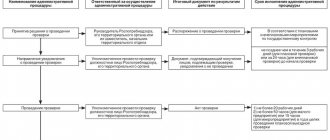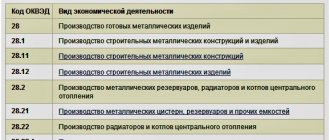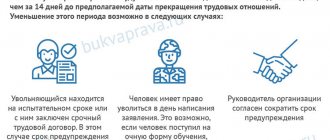The Labor Code of the Russian Federation allows for the possibility of employment for additional work. An employee can perform additional duties simultaneously with his main job or in his free time. Depending on this, the employer arranges a part-time job (internal or external) or a combination with the employee. This article deals with internal part-time work, its differences from combination work, and the correct registration of an employee for additional work in accordance with current legislation.
Part-time work: concept and types
Quite often, an enterprise has employees registered as part-time workers.
Part-time work means that an employee works in one organization in the main position and at the same/another enterprise performs some regular type of activity in free time (Article 282 of the Labor Code of the Russian Federation). The key words in this case are “free time” and “regularity”.
Part-time work can be:
- external – when the main and additional work is in different organizations;
- internal - additional work in the same organization as the main one.
Registration of a full-time employee as a part-time worker is often more profitable than searching for and hiring an applicant from outside (despite the fact that even after completing his studies he can refuse this job). Workers also benefit from the institution of part-time work, as it allows them to receive additional income.
The specificity of part-time employment is that the conditions of such work are made dependent on the applicant’s main job for the position. That is, if the applicant does not have a main job, then he cannot be hired for a part-time job.
do not provide for any restrictions related to the number of registrations by a part-time worker . That is, you can apply for a part-time job as many times as necessary (depending only on desire and strength).
Design nuances
Additional work, as mentioned above, can only be obtained at one enterprise or in one organization or institution.
But this workplace is not necessarily located in the same building (building); however, the employer adheres to the principle of accessibility and proximity of workspaces for the employee who received the combination.
More often, similar (similar) positions are combined, but it is also possible to replace an absent colleague or hire a vacant position for another position. In this case, the availability of free space is confirmed by the timesheet and staffing table. According to the information contained in these documents, the reason for the employee’s absence and the possibility of replacing him with another employee are clear.
The scope of activity of a temporary deputy is determined by the nature of the position:
- If an employee takes a position in his profession, he will have to expand his responsibilities without a clear delineation of official powers.
- If an employee has received a position in a position other than his main job, he expands his responsibilities with a clear definition of the type and order of work performed.
It should be noted that the combination can be either urgent (time-limited) or indefinite.
In the latter case, there is a risk of termination of the employment relationship, since labor legislation allows the combination to be terminated at the request of one of the parties.
In this case, the interested party sends a written notice to the other party within three days, and then terminates the employment relationship.
The combination itself contains quite a lot of controversial issues, for which workers go to court for resolution. For example, disputes arose about the calculation of regional coefficients or whether the assigned additional payment corresponded to the volume of work performed.
Internal part-time and combination: what is the difference
Very often the concepts of “internal part-time work” and “combination” are confused, considering them synonymous. In fact, these are 2 different options for designing additional work.
Article 60 of the Labor Code of the Russian Federation
prohibits requiring an employee to perform duties not stipulated by his employment contract. Therefore, if an employer needs an employee to expand the range of his duties, perform work in a different profession, or replace a temporarily absent employee, the legislation provides 2 options for registering additional work for an already registered employee:
- Part-time job.
- Combination.
Part-time work represents the full performance of duties by an employee with the mandatory conclusion of an employment contract (Article 60.1 of the Labor Code of the Russian Federation). In this case, additional work is performed regardless of the main duties in the time free from the main job.
Part-time work is regulated by Chapter 44 of the Labor Code of the Russian Federation. The part-time procedure for teachers and doctors has certain features . It is determined by decrees of the Government of the Russian Federation for each category of these persons.
Part-time jobs are issued for vacant positions. After registration, the part-time worker is assigned an independent personnel number.
Keeping records of the working hours of a part-time employee and the main position is done separately.
If the employer finds another employee for a part-time position, for whom this work will be the main one, he can fire the part-time employee. This right of the employer is provided for in Art. 288 Labor Code of the Russian Federation. In this case, the part-time partner must be notified 2 weeks before the date of termination of the contract.
But internal combination is the performance by an employee of an organization of additional duties without interruption from his main job. In this case, the new work is performed within the framework of one employment contract:
- for the same position (increased volume of work);
- related position (expansion of responsibilities).
The combination does not require the presence of vacant positions. It can also be issued for occupied position (for example, during the absence of the main employee).
The possibility of combination must be provided for in the collective agreement or local act of the organization.
There is no need to show the combination on the time sheet.
For greater clarity, let us combine the distinctive features of internal part-time and combination in the table.
Table: distinctive characteristics of internal part-time and combination
How to register a combination of positions at an enterprise
When assigning additional work to an employee, in addition to the work specified in the employment contract, the following must be taken into account (Part 1, 4, Article 60.2, Article 151 of the Labor Code of the Russian Federation):
- make an offer to the employee. It can be made in writing or orally (Example Sentence);
- assignment of such work is permitted only with the written consent of the employee (Example application);
- this work is subject to additional payment. The combination is formalized by order of the manager (Example of an order on combination). The condition on combining professions (positions) and the amount of additional payments can be established immediately upon concluding an employment contract. If there is already an employment contract, then the combination condition is stated in the additional agreement to the employment contract (sample additional agreement to the employment contract). In the event of a vacant position, an additional agreement to the employment contract on the cancellation of the combination and a corresponding order are made with this employee;
- the employee is not released from the main work provided for in the employment contract.
Required documents for part-time employment:
- passport;
- pension insurance certificate;
- TIN, marriage certificate and birth certificate of children (but they are not required);
- an educational diploma may be required only if the employment requires specialized knowledge and skills.
The list does not include a work book - it must be located at the place of primary employment.
Internal part-time job
Part-time work can be internal. This is work for the same employer in two types of employment - main and additional.
In this case, 2 employment contracts must be drawn up for each type of activity.
What cannot be included in the contract
The main thing is to avoid two dangerous formulations in the employment contract, for which the employing organization can be held liable.
Prohibition No. 1
- The first thing that Rostrud employees categorically do not like in the employment contracts of Russians is the individual allowance for combinations. Officials emphasize that any additional payment for combinations may depend only on the actual amount of work. At the same time, the employer should not take into account the qualifications of the employee who is working part-time and the amount of his basic salary. When assigning the same additional work to several employees, the organization’s management must offer the same amount of additional payment for it.
- If in the employment contract this amount is tied to the salary, then during the inspection, labor inspectors may fine the employing company for discrimination against employees, which is prohibited by Article 132 of the Labor Code of the Russian Federation. In accordance with the sanctions of Article 5.62 of the Code of Administrative Offenses of the Russian Federation, the fine for such an offense can reach 100,000 rubles.
Prohibition No. 2
- The second prohibited clause of the employment contract concerns regional coefficients. They cannot be included in the employment contract as part of the salary. Article 129 of the Labor Code of the Russian Federation defines that salary is remuneration without taking into account compensation, incentives and social payments. Therefore, all increasing coefficients must be specified separately in the employment contract. This is necessary so that the employee clearly understands what parts the payments in his favor consist of, what is a salary and what is an allowance. In the employment contract and pay slip, it is necessary to indicate separately all types of payments that make up the employee’s total income.
- If you ignore this requirement, labor inspectors may fine the organization under Article 5.27 of the Code of Administrative Offenses of the Russian Federation for incorrect execution of the employment contract. The minimum fine in this case is 50,000 rubles, and the maximum is 200,000 rubles.
Is an entry made in the work book?
An entry about the combination is not made in the work book.
Obligations performed under one contract do not require additional documentation.
How to show it on the timesheet?
Work execution is not included in the timesheet.
Internal part-time work: limitations and features
There are categories of workers for whom part-time work is prohibited by labor legislation. So, in accordance with Art. 282, 329, 276 of the Labor Code of the Russian Federation it is unacceptable to hire as part-time workers:
- minors;
- persons who work in their main job with harmful (dangerous) working conditions - if the part-time job is in similar conditions;
- employees of state and municipal institutions;
- persons whose main work is related to driving vehicles or their movement - if the planned part-time work is similar;
- military personnel (except for such fields as pedagogy, science and creativity) - provided that such part-time work will not interfere with the performance of military duties;
- security guards - in relation to public service and paid work in public associations;
- judges, lawyers, prosecutors (except for such industries as pedagogy, science and creativity);
- heads of organizations - without consent to part-time work from the general meeting of the organization's participants (board of directors) from the main place of work.
Internal part-time work has a number of features:
- Internal part-time work is, in fact, additional work performed in free time from the main job in the same organization.
- a separate must be concluded between the employee and the employer (Article 282 of the Labor Code of the Russian Federation).
- Since the internal part-time worker has already been registered with this employer, he does not need to provide any documents to conclude an employment contract. An exception is a document confirming the competence of a part-time worker if the new job requires special qualifications.
- in the employment contract and in the hiring order an internal part- who is being hired .
- Full -time internal part-time work is not possible.
- a separate time sheet is kept for the employee
- An entry about part-time work in the work book is made at the request of the employee (Article 66 of the Labor Code of the Russian Federation).
Documenting
If a combination of jobs is established for a new employee upon hiring, then there is no need to draw up a separate employment contract for the combination. In the employment contract with the employee, reflect both the conditions for performing the main job and the conditions for performing part-time work. Based on the contract, issue an order for employment, indicating in it the combination of professions (positions).
When drawing up an order, the organization can, at its own choice:
- use the unified form No. T-1, approved by Decree of the State Statistics Committee of Russia dated January 5, 2004 No. 1;
- apply an independently developed form approved by the head (provided that it contains all the necessary details provided for in Part 2 of Article 9 of the Law of December 6, 2011 No. 402-FZ).
This procedure follows from Part 4 of Article 9 of the Law of December 6, 2011 No. 402-FZ and is confirmed by the letter of Rostrud of February 14, 2013 No. PG/1487-6-1.
If a combination is established for an employee already working in the organization, be sure to obtain his consent to the combination (Part 1, Article 60.2 of the Labor Code of the Russian Federation). Document the parties' consent to the combination in the form of an additional agreement to the employment contract (Part 1, Article 60.2 of the Labor Code of the Russian Federation). Indicate in it:
- the work (position) that the employee will perform additionally, its content and volume;
- the period during which the employee will perform additional work;
- amount of additional payment for combining professions (positions).
Such requirements for registration of combinations are provided for in Part 3 of Article 60.2 of the Labor Code of the Russian Federation.
Based on the concluded additional agreement, issue an order on combining professions (positions). The standard form of such a document is not provided for by law, so draw up the order in any form.
Do not enter information about combinations into the employee’s work book (Section 3 of the Instructions approved by Resolution of the Ministry of Labor of Russia dated October 10, 2003 No. 69).
If the position (profession) that the employee will hold involves direct servicing or use of money, goods, as well as other property of the employer, then additionally enter into an agreement with the employee on full financial liability (Articles 241–243 of the Labor Code of the Russian Federation).
Example of registration of combining positions
Accountant of the organization V.N. Zaitseva agreed to combine her position with the position of chief accountant. Based on an additional agreement to the employment contract, the head of the organization issued an order to combine positions.
Situation: how to reflect the condition of combining professions in the employment order in the T-1 form. Does the organization use unified forms of personnel documents?
In the line “Conditions of employment, nature of work” of the order on form No. T-1, indicate: “Under the conditions of combining with the position (name of position).” The form of the employment order was approved by Resolution of the State Statistics Committee of Russia dated January 5, 2004 No. 1.
Remuneration for internal part-time workers
Remuneration for internal part-time workers occurs in accordance with Art. 25 Labor Code of the Russian Federation.
Here are the types of remuneration for internal part-time workers:
- time-based – proportional to working hours;
- piecework - depending on output;
- by agreement of the parties - the conditions are specified in the employment contract.
The guaranteed wages of a part-time worker are fixed in the employment contract, taking into account the wage system at the enterprise (Article 135 of the Labor Code of the Russian Federation).
A part-time employee has the right to receive allowances, bonuses and other compensation and incentive payments on a general basis - if such additional payments are provided for by regulations, collective agreements and contracts, and internal regulations of the employer.
Payment
Additional remuneration is calculated taking into account the current employment
legislation, namely Article of the Labor Code numbered 60.2, local documents (Regulations on payment adopted by an enterprise or organization), as well as the agreement reached by the parties (it is recorded in an additional agreement and order).
Such payment may be:
- Fixed, pre-established in local documents of an organization or enterprise.
- Depends on the volume of work performed. For example, a turner can be paid money based on the production of products.
- Depends on the nature of the additional duties performed. For example, for teachers who have taken on additional responsibilities as a class teacher, additional payment is made according to the hours worked.
Additional payment is guaranteed to employees who have taken on additional work responsibilities by Article 151 of the Labor Code.
Such payments are assigned both when combining positions and professions, implying:
- expansion of service area and responsibilities;
- increasing the volume of work performed without exemption from core activities.
How many bets are possible under the Labor Code of the Russian Federation for internal part-time work?
The tariff rate is included in the tariff system for differentiating wages of workers of certain categories (Article 143 of the Labor Code of the Russian Federation).
In practice, normal working hours are 8 hours per day (40 hours per week). This is the length of the working day that corresponds to the full tariff rate. At the same time, Part 1 of Art. 284 of the Labor Code of the Russian Federation establishes a limit on working hours for part-time work - no more than 4 hours a day. Consequently, in proportion, a part-time worker can be hired for no more than 0.5 of the tariff rate.
However, Part 1 of Art. 284 of the Labor Code of the Russian Federation allows that a part-time worker can work full time (shift) if he is free from performing job duties at his main place of work.
So, under standard working conditions, an internal part-time worker can only work at 1.5 times the wage rate (full rate at the main place of work + 0.5 times the internal part-time rate).
How do you pay
Payment is made according to the terms of the employment contract, but there is one caveat. Many managers do not know whether internal part-time workers need to be paid up to the minimum wage, or whether they can simply act on the basis of a contract. In order not to break the law, you must comply with Article 133 of the Labor Code of the Russian Federation, which states that the salary of an employee who has worked the standard working hours cannot be lower than the minimum wage. So, in Russia there is a 40-hour work week, that is, the norm is 8 hours a day.
A part-time worker who works part-time receives a salary in proportion to the standard. That is, if a specialist is hired part-time, then he is obliged to work 4 hours and receive half the minimum wage for this, for a quarter of the time - 2 hours and a quarter of the minimum wage, etc. If the salary is less than the standard (provided that the required hours were worked) , then the employer is obliged to pay the difference, adding it to the required amount. That is, if a person works full-time and part-time, then his salary cannot be less than the minimum wage + 1/2 the minimum wage.
Algorithm for hiring an internal part-time worker
Registration of internal part-time work occurs in the following order:
- The part-time worker writes an application for internal part-time work.
- A separate employment contract is drawn up .
- Issue an order to hire an employee; it must make reference to the employment contract.
- At the request of the employee, you can make a note in the work book about working on a part-time basis.
Documents for internal part-time work and part-time work from the employee
When applying for an internal part-time job, the employee must first write an application .
In principle, an application for a part-time job is not very different from the application that an employee writes when applying for a main job.
Sample employee applications for internal part-time and part-time employment can be downloaded for free using the links:
In case of internal part-time and part-time work, the employee does not need to present the employer with a passport and education documents again, since they have already been provided to the HR department when hired for the main job.
The only exception in this case is the employment of the main employee for additional work, which requires the presence of other qualifications.
Differences between combination and part-time
Often an equal sign is put between these concepts, but this is fundamentally wrong. Combination involves performing several duties, identical or not to the main position, during one work shift. Payment is made as a percentage of salary or a fixed amount. There are no additional privileges in this case.
Part-time work is the performance of certain jobs in your free time from your main job. Therefore, payment is made based on the amount of wages provided for these types of work and based on the actual time worked. The employee receives vacation for all professions, as well as vacation pay.
Part-time employment contract
An employment contract with an internal part-time worker is not very different from a standard employment contract.
It is traditionally concluded in 2 copies - one for each side. The main difference is that it must contain the mark “ on a part-time basis .”
Also, the contract must separately specify the number of working hours , since, in accordance with labor legislation, the number of working hours of a part-time worker must be half less than the working hours of the main job for a calendar month.
In addition, according to the standard, an employment contract must include the following employment conditions:
- rights and obligations of the employee and employer;
- wages and social guarantees;
- working time and rest time;
- liability of the parties to the contract;
- amendment and termination of the employment contract;
- contract time.
An employment contract with an internal part-time employee can be fixed-term or indefinite , depending on the agreements between the parties and the specifics of the work performed.
Registration procedure
Both parties can initiate the assignment of additional job responsibilities, but the basis for formalizing additional job responsibilities is always consent expressed in writing:
If the employer wants to entrust additional responsibilities, he sends the employee a memo with an offer to take the position. The employee must sign this document, expressing his consent, or refuse to sign.
If an employee wants to occupy a vacant workplace, he must submit an application to management with a corresponding request. On this document, the employer expresses his agreement or disagreement using a short summary.
Both of these forms of documents have legal force only after their agreement (approval by the interested parties).
These documents are the legal basis for issuing an order and signing an additional agreement (if we are talking about long-term combination).
The application is written in free form by hand. This document does not have a unified form.
Required items to fill out:
- An appeal to the employer indicating the name of the organization or enterprise, as well as the full name and position of the immediate supervisor.
- Indication of information about the employee submitting this document (his full name and title of position).
- A brief statement of the request indicating the position for which the employee is applying.
- Signature and date of preparation (submission) of the document.
The memo is also written by the employer in free form and includes the following points:
- Full name of the organization or enterprise, registration number of the document, full name of the employee and his position.
- Title of the document (combination proposal).
- A summary of the proposal describing the duties and responsibilities of the vacant or temporarily vacant position.
- Information on the amount of the established surcharge and the procedure for its provision.
- Signature of the manager and date of drawing up the memo.
After agreeing on all the nuances, the new employment relationship is documented, which includes two stages:
- Drawing up and signing of an additional agreement. This document is initially prepared by the HR department in two copies, one of which is handed over to the employee.
- Issuance of an appropriate order approving the amount of additional payment and changes in the staffing table. This document also serves as the basis for the calculation and payment of additional remuneration.
Can internal part-time work become the main job?
Labor legislation does not provide for a ban on the transition of internal part-time work to the category of the main job.
There are two ways to make such a transition:
- is dismissed from the main place of work an additional agreement on the transition is drawn up to the part-time employment contract .
- The employee is completely dismissed from both positions and then rehired with a new employment contract .









